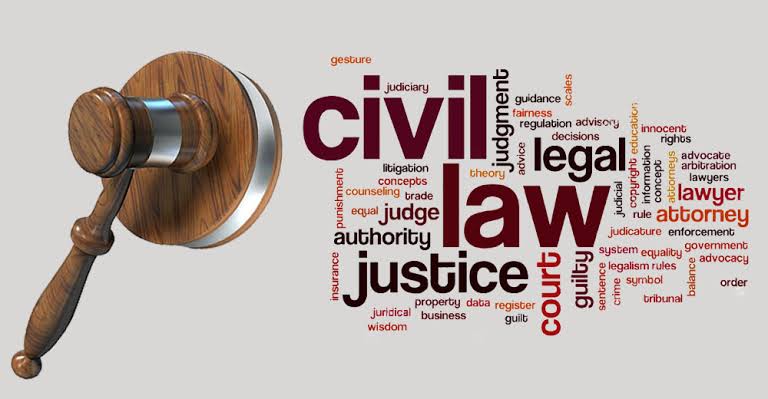Table of Contents
Introduction
The origin of civil law can be traced to Justin. Justin had codified the principles of civil law in his book Corpus Juris Civilis, a Roman treatise. He is also called the father of Civil Law.
In the beginning there were only civil rights and there were no rights given by criminal law. During the 7th century, it was realized that there were some infringements which affected the society as a whole, therefore the state decided to fight against them, which later gave rise to the development of criminal law.
Therefore, criminal law arises from Civil Rights. It means the law against the infringement of those rights which the state will prohibit and the only and product will be suffering. While under English law before the Judicature Act the law of procedure assumed great importance. However, under modern English and Indian laws, the tendency is to treat it as subordinate and as a mere accessory to substantive law.
Evolution of Civil Procedure System In India
The development of Code of Civil Procedure, 1908 began in the year 1859 when the first uniform Code of Civil Procedure was enacted. Before 1859, the procedure in the civil litigation was in a chaotic and coherent condition. Simce, there was no uniform law of procedure applicable to the country, different provinces and areas had adopted different procedures to govern themselves.
Code Of Civil Procedure,1859
Sir Charles Wood, made effort in that direction of evolving a uniform procedure and directed the Second Law Commission to prepare a code of simple and uniform procedure applicable to all the Courts. The Commission had submitted four drafts of the Code of Procedure which were intended to apply to Ordinary Civil Courts of lower Provinces of Bengal and Presidencies of Madras and Bombay and North Western Province. These four bills based on drafts were amalgamated to enact a uniform Code of Civil Procedure, 1859, which was applied to the Mofussil Courts only.
The Code of Civil Procedure,1859 was not applicable to the Supreme Court established in the Presidency towns and Presidency Small Causes Courts. There were many lacunas in the Code of 1859 which needed to be reformed. During 1863 & 1864, Mr. Harrington prepared a comprehensive Bill to replace it, but for some reasons, the enactment of the Bill was deferred. In the meantime, many acts dealing with particular branches of law were enacted that necessitated corresponding changes in the Code of Civil Procedure, 1859.
Code Of Civil Procedure, 1877
Later, Dr. Whitley Stokes, the then (Secretary to the Government of Indian) in the Legislative Department rearranged the said draft Bill prepared by Mr. Harrington in a systematic manner as per the provision of the Code of 1859. He introduced a number of new provisions based on Orders and Rules made under the Judicature Acts in England and also borrowed certain provisions of the New York Civil Code. Sir Arthur Hobhouse, the then Law Member, made substantial contributions to the draft Bill, with certain modifications, the Bill was enacted as the Code of Civil Procedure, 1877.
Code Of Civil Procedure, 1882
After the enactment of the Code of Civil Procedure, 1877 it was realized that this Code requires several amendments. As many as 130 Sections of the Code were amended in 1879. When further amendments were proposed in 1882, it was decided that the Code should be completely recast. Hence, the Code of Civil Procedure, 1882 was enacted. The Code of Civil Procedure, 1882 had been in force for nearly 25 years.
Code Of Civil Procedure, 1908
It was observed that in respect of some matters the provisions of the Code of 1882, were too rigid to sufficiently meet the varying needs of the different areas of the country. Also, there was conflict of judicial opinion relating to the interpretation of certain provisions of the Code. Thus, the revision work of the Code was undertaken by a Select Committee which was headed by Sir Earle Richards. It collected valuable material on the subject and prepared a draft Bill. After examination of the bill, the Code of Civil Procedure, 1908 was enacted.
The present law relating to the procedure in suits and civil proceedings in India is contained in the Code of Civil Procedure, 1908. The Code has been amended from time to time by various Acts of the Central and State Legislatures. Under Section 122, the High Courts have powers to amend, through Rules, the procedure laid down in the Orders. In exercise of these powers, various amendments have been made in the Orders by the different High Courts. The Code of Civil Procedure, 1908 provides a detailed scheme of the law relating to civil procedure.
Scheme of the Code
The Code of Civil Procedure, 1908, can be divided into two parts namely;
- The Body Of The Code: It contains a total of 158 Sections. The Sections deal with provisions of a substantive nature, laying down the general principles of jurisdiction which cannot be changed except by the legislature.
- The First Schedule: It contains 51 Orders with every Order containing Rules. These rules relate to the procedure and the method, manner and mode in which the jurisdiction may be exercised. The (First) Schedule of the Code, containing Orders and Rules, on the other hand, can be amended by High Courts.
Looking at the scheme of the Code as a whole, it becomes abundantly clear that the amendments made by High Courts in the Rules contained in the First Schedule also become part of the Code for all purposes “as if enacted in the Code”. The Sections and the Rules, therefore, must be read together and harmoniously construed. However, in a situation where the rules are inconsistent with the Sections, the latter will prevail.
Thus, Bombay High Court in Amrut Ginning Factory v. Namobai Tanaji Pawar, observed:
“It is well settled principles of interpretation that all the provisions of the Code should be interpreted harmoniously, but if the Rules are inconsistent with the sections, the former will have to give way to the latter.”
Development of the Civil Procedure Code
CPC is a legal framework in India that governs the procedures for civil litigation. It was enacted during the British colonial period and has since undergone several amendments. Here is a brief overview of its development:
Code of Civil Procedure (Amendment) Act, 1951 & 1956
There has been no significant change in the Civil Procedure Code of 1908, till Indian independence. There were many lacunas and confusion in the code which demanded serious improvement. Therefore, two important amending Acts were enacted namely, the Code of Civil Procedure (Amendment) Act, 1951 & 1956, which mainly embodied certain changes which are as follows:
- Introduction of Order 6A: This order dealt with summary procedures and allowed for the speedy disposal of certain types of cases.
- Order 7 was amended: It specified that a plaint should contain a statement of the value of the subject matter in dispute.
- Amendment Of Order 21: Changes were made to the rules regarding the execution of decrees and orders.
- Order 23: Provisions regarding compromise of suits were modified.
- Introduction of Order 37: This order introduced a procedure for the speedy recovery of commercial debts.
- Amendments related to jurisdiction: Changes were made to the rules regarding jurisdiction of courts in civil matters.
Code of Civil Procedure (Amendment) Act, 1976
Despite the 1951 and 1956 amendments some defects remained in the Code. The Law Commission in its various reports on “Reform of Judicial Administration” indicated broad lines on which the Code should be revised, but left more detailed examination of the revision to be undertaken distinctly.
After considering the recommendations of the Law Commission, the government decided to put forward the Bill for the amendment of the Code of Civil Procedure, 1908, keeping in view, the following considerations:
- A Litigant should get a fair trial in accordance with the accepted principles of natural justice.
- Every effort should be made to expedite the disposal of civil suit and proceedings, so that justice may not be delayed.
- The procedure should not be complicated and ensure a fair deal to the poorer sections of the community who may not have the means to engage a pleader to defend their cases.
Many important changes were made by the Amending Act 1976, which are as follows:
- The doctrine of Res Judicata being made more effective.
- The power to transfer proceedings from a High Court in a State to any other High Court was conferred on the Supreme Court.
- Interest for the post-decretal period in respect of liabilities arising out of commercial transactions has been increased.
- The freedom from attachment of a portion of salary now available to a government servant or a servant of a railway company or local authority. This protection has been extended to all salaried employees.
- The right to prefer an appeal against a decree passed in a suit of the nature cognisable by a Court of Small Causes restricted in respect of cases in which the amount or value of the subject-matter of the original suit does not exceed In such cases, appeals are allowed only on questions of law.
- Second appeals are allowed only on such questions as are certified by the High Court to be substantial questions of law.
- It has been provided that there will be no further appeal against the decision of a Single Judge of a High Court in a second appeal.
- Section 132 provides that women, who, according to the customs and manners of the country, ought not to be compelled to appear in public, shall be exempted from personal appearance in courts.
- The period during which a member of a legislature cannot be arrested and detained under a civil process increased from 14 to 40 days.
- Provisions made to ensure that written statements and documents are filed without delay.
- New Order 16-A has been inserted to provide for the attendance of prisoners in courts for the purpose of giving evidence.
- New Order 32-A has been inserted to provide a special procedure in litigation concerning the affairs of a family.
- The practice of passing preliminary and final decrees in mortgage suits and other suits has been abolished. In such suits, there will be only one decree, so that there may not be more than one appeal in a suit.
- The scope of summary trials has been substantially widened.
Code of Civil Procedure (Amendment) Act, 1999 & 2002
The amendments made in 1976 carried out drastic changes in the Sections, Orders and Rules, but were not found sufficient. Thus, in Manohar Lal v. Seth Hiralal, the Supreme Court observed that the “The Code is not exhaustive as the legislature is incapable of contemplating all possible circumstances which may arise in future litigation and consequently for providing procedure for them”.
Justice Malimath Committee was appointed by the government with a view to dispose of civil cases expeditiously. In pursuance of recommendations of the Committee, the Code was amended by the Amendment Acts of 1999 and 2002. Important amendments made by the Acts of 1999 and 2002 may be summarized as:
- In every Plaint, facts shall be proved by an affidavit.
- Time limit has been prescribed in several matters, such as issuing of summons, filing of written statement, amendment of pleadings, production of documents, examination of witness, pronouncement of judgments, preparation of decree.
- The Court may reformulate the terms of a possible settlement and refer the same for: arbitration; conciliation; judicial settlement including through Lok-Adalat; mediation. Thus, an alternative mode of settlement of disputes has been introduced.
- Numbers of adjournments have been restricted.
- A provision for recording of evidence by the Court Commissioner has been made.
- A provision has been made for filing of appeal in the Court which passed the decree.
- Instituting an appeal against the judgment is allowed where the decree is not drawn up.
- Scope of first appeal, second appeal, letters patent appeal and revision has been curtailed.
Conclusion
On the basis of discussion, it is clear that India is a vast country and many different cultures coexist here. Due to such diversity in culture there arises conflict of ideologies. Problems related with property and family etc are major problems of any state. The current civil procedural code is not well equipped to deal with such matters effectively, and time and again there have been many amendments made to upgrade the civil procedural laws in the country.
Reference Links
- Code Of Civil Procedure- Second Edition- By Jatindra Das Kumar
https://books.google.com/books?id=7MvJEAAAQBAJ
- CPC and Limitation by MP Jain
https://id.scribd.com/document/477017230/CPC-and-Limitation-by-MP-Jain-pdf
- Does India Need New Civil Procedure https://www.legalserviceindia.com/legal/article-1043-india-needs-new-civil-procedure-code-or-not.html
- Kailash vs Nanhku and Ors.- Indian Kanoon
https://indiankanoon.org/doc/877414
- Judgment Advanced Search
http://www.clcbd.org/judgment/search.html?q=installments+of+principle+amount



